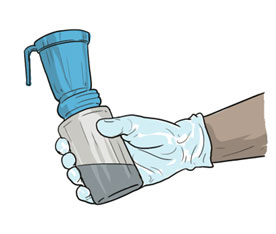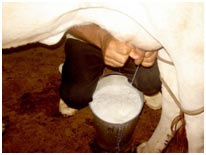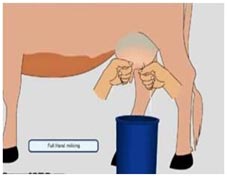 |
|
|
Translate this page in your preferred language:
|
| MILKING OF DAIRY ANIMALS : |
| Back |
Milk and its composition :
-
 |
|
Characteristic color of milk |
- Milk contains approximately 86% water, 4.7% sugar (lactose), 4.1% fat, 4.2% protein and 1% minerals.
- It supports the growth of micro-organisms and thus is prone to contamination. The purpose of milking a dairy cow is to obtain milk that is fit for human consumption.
- Milk from the udder of a healthy cow contains very few bacteria and to ensure that it remains fresh for long it should be handled under conditions of good hygiene.
- Unclean milk can be a source of disease to the consumer, rejected at the market and so is a loss to the farmer, does not keep for long and is not good for processing.
Milking Hygiene :

Good Practice:
- Washing hands with soap and water before milking each cow.
- Washing the udder and each teat vigorously with soap and water and dry them with a clean cloth
- Direct the first milk outside the milking bucket into separate container and throw away.
- Have a clean, dry, floor preferably of rough surfaced concrete without sharp points for the milking area.
- Keep calves where cows can see them during milking.
- Use clean containers for milking and before re-using the milk container, rinse it, scrub it with warm water and detergent or soap, rinse it again leave it to air-dry.
- After milking, cover the milk to avoid contamination and place in a clean and cool area.
- Keep the area clean and safe for animals.
Bad Practice:
- Using Milk from sick cows can transmit diseases to humans.
- Using unclean plastic containers.
- Leaving milk uncovered.
- Keeping the milk in the sun or outdoors.
Methods of Milking:
1. Hand milking, and
2. Machine milking
1. Hand milking:
Cows are milked usually from left side. Milking can be done either cross wise or forequarters together and then hind quarters together or teats appearing most distended milked first. The first few strips of milk from each quarter should be discarded as it contains highest number of bacteria
Types of Hand milking
I. Stripping
II. Full hand method.
I. Stripping-
Stripping is done by firmly holding the teat between the thumb and fore finger and drawing it down the length of the teat and pressing it to cause the milk to flow down in a stream.
II. Full Hand method-
Grasping the teat with all the five fingers and pressing it against the palm. The teat is compressed and relaxed alternatively in quick succession. The method removes milk much quicker than stripping as there is no loss of time in changing the position of the hand. Full hand milking should be followed by stripping to remove the residual milk.
Full hand method is superior to stripping because it stimulates the natural suckling process by calf and this method exerts an equal pressure on the large teats of cows and buffaloes.
- Many milkers during milking tend to bend their thumb against the teat. The method is known as
knuckling which causes injury to teat tissues.
- Thus milking should always be done with full hand unless the teats are too small or towards the completion of milking
- The first few strips of milk from each quarter should not be mixed with the rest of the milk as the former contains highest number of bacteria.
2. Machine Milking:
 |
| Machine milking |
Modern milking machines are capable of milking cows quickly and efficiently, without injuring the udder. The milking machine performs two basic functions:
- It opens the streak canal through the use of a partial vacuum, allowing the milk to flow out of the teat cistern through a line to a receiving container.
- Massages the teat, preventing congestion of blood and lymph in the teat.
Advantages:
- Easy to operate, costs low, saves time as it milks 1.5 liter to 2 liters per minute.
- It is also very hygienic and energy-conserving as electricity is not required.
- All the milk from the udder can be removed.
- The machine is also easily adaptable and gives a suckling feeling to the cow and avoids pain in the udder as well as leakage of milk.
Practical Aspects of Milking:
Steps:
The cow is brought to the milking parlor as calmly as possible. Frightening the animal at this stage has a negative effect on milk let down due to release of adrenaline (hormone) which has a negative effect on milk letdown.
- Feed the cow its production ration (this is optional depending on the feeding system). This calms the animal and stimulates milk letdown.
- Restrain animal - tie hind legs above hock joint in the form of a figure 8.
- Wash hands with soap and clean water before milking. Dry hands with towel.
- Test for mastitis using a strip cup - strip first few rays of milk into strip cup from each quarter and observe for any abnormalities. If mastitis is detected, the cow should be milked last.
- Wash udder with warm clean water with disinfectant using a clean towel.
- Warm water also stimulates milk let down. Dry udder using a dry towel.
- Apply milking jelly - prevents cracking of teats and eases milking (for hand milking only)
- Milk quickly and completely by squeezing the teat, do not pull. Milking each cow should take 5-6 minutes at most.
- Use clean containers for milking.
- After milking: Strip the animal - getting last drops of milk from udder to avoid incomplete milking (can lead to mastitis).
- After milking dip the teats in a teat dip (disinfectant to ensure that bacteria do not gain entry through the teat sphincter which is loose immediately after milking).
- It is recommended that the animal remain in a standing position for at least one hour to ensure the teat does not come into contact with the ground while the sphincter is still loose.
Note:
- Routine milking procedures stimulate milk letdown and should therefore not be changed unnecessarily.
- After cow has been maximally stimulated for milk let down, it should be milked immediately since the stimulus reduces over time. Oxytocin effects are maximum between 5-6 minutes, thus milking should be completed during this time.
- Don't harass animal since adrenaline (hormone produced due to fright) has opposite effect of oxytocin (milk let down hormone).
Comparison of cow and buffalo milk:
| Trait |
Cow |
Buffalo |
| Total solids (%) |
13.10 |
16.30 |
| Fat (%) |
4.30 |
7.90 |
| Protein (%) |
3.60 |
4.20 |
| Lactose (%) |
4.80 |
5.00 |
| Tocopherol (mg/g) |
0.31 |
0.33 |
| Cholesterol (mg/g) |
3.14 |
0.65 |
| Calcium, Ca (mg/100 g) |
165 |
264 |
| Phosphorus, P (mg/100 g) |
213 |
268 |
| Magnesium, Mg (mg/100 g) |
23 |
30 |
| Potassium, K (mg/100 g) |
185 |
107 |
| Sodium, Na (mg/100 g) |
73 |
65 |
| Vitamin A, incl. carotene (I.U.) |
30.30 |
33 |
| Vitamin C (mg/100 g) |
1.90 |
6.70 |
 |
|
 |
|
Milking parlor |
|
Step by step method of hand milking |
 |
|
 |
|
Dipping cow teats in disinfectant |
Handling the milk:
The following guidelines should be followed to avoid milk spoilage:
- Filter milk immediately after milking: Use a white filter cloth or strainer. Disinfect, wash and dry the cloth/strainer after use.
- Always handle milk in clean, preferably metal, containers.
- When transferring milk between containers, pour the milk instead of scooping since scooping may introduce spoilage bacteria.
- Do not store milk at high temperatures.
- Do not handle milk if you are sick. Seek medical treatment and resume work only when the doctor says you are fit to do so.
- Store milk in a cool clean place preferably lockable room set aside for milk only. If storing overnight, keep the milk in cold/ chilled water.
- Deliver milk to the market as soon as possible preferably in the cool morning or evening.
Proper cleaning of milk equipments:
Milk cans:
Immediately cans are emptied of milk they should be cleaned as follows:
- Rinse with cold water.
- Scrubbing with brush and warm detergent (any un-perfumed liquid soap will do).
- Rinse with cold water.
- Sterilize (sanitize) with boiling water or steam if available or use dairy sanitizing solution such hypochlorite or commercial brand preparations in accordance with manufacturer’s instructions.
- Dry cans on a drying rack. Exposure to sunlight will enhance killing off bacteria during drip drying of cans.
Milking machines:
Milking machines should be cleaned according to recommended practice:
- Rinse with cold water.
- Use the “cleaning-in-place” (CIP) method where detergent in hot water is circulated in the system.
- Rinse with hot water.
Clean Milk Production:
Importance :
Milking:
The milking procedure is the first step in obtaining clean milk. At the farm this starts with ensuring the cow to be milked is healthy.
The Cow:
- Feeding very high amount of concentrates and low amount of forages result in milk with low butter fat. On the other hand feeding too little concentrates leads to low milk yield.
- An unhealthy cow will feed less and produce less milk.
- Farmers are encouraged to vaccinate their animals against brucellosis. Animals should also be checked periodically for all types of contagious diseases and treated promptly in case they are infected.
- Mastitis is an inflammation of the mammary glands in the udder caused by infection with disease-causing bacteria which can be controlled by observing general hygiene and proper milking procedure.
Guidelines for clean milk production :
The milker : Should:
- be healthy and clean.
- Maintain short nails and hair (for ladies, cover the head when milking)..
- Never smoke during milking time.
- Milk quickly and completely without interruptions.
The environment :
- A milking shed (parlor) which can be permanent or movable should be constructed.
- It should be located away from any smells.
- The floor of shed should be clean and dry and if possible have a cement floor for ease of cleaning.
- The shed should be cleaned after every milking and animals kept off outside milking time.
Equipments:
- Use seamless aluminum or stainless steel cans for milking and storing milk. Plastic container is difficult to clean.
- Clean utensils immediately after milking or after emptying milk: rinse with cold water, scrub with a brush using hot water with detergent then rinse with cold water.
- Place upside down on a rack and dry in the sun.
- Store utensils in a safe, clean and well ventilated room.
Sources of milk contamination that needs to be avoided:
Milk containing dirt, dust, foreign materials, and high bacterial count and with off flavor is called contaminated milk.
Milk is contaminated by various sources:
- Udder:
Unsanitary conditions of milking barns and bedding of the animal causes bacterial growth. Such bacteria may enter in to the udder through teat canal, which causes infection the udder like mastitis resulting contamination of milk.
The fore milk may be discarded as it contains high bacterial counts. Complete milking should be done. Incomplete milking may lead to infection of the udder.
- Exterior of cow's body:
Bacteria present on the animal body may enter in to the milk at the time of milking. Maintenance of clean skin, washing flank and udder with clean damp cloth before milk reduces the contamination from this source.
- Milking barns:
It should be provided with good ventilation and neat flooring. Dry feeds or forage should be fed after milking.
- Milker:
Dirty hands and clothing of the milker may be the source of contamination causing spread of bacterial diseases to the consumer through milk.
Persons suffering from diseases like T.B., Typhoid fever, diphtheria may not be employed for milking. Dirty habits like smoking, drinking should be avoided.
- Utensils:
Clean sanitized, smooth copper free and dry utensils may be used for handling milk.
|
|
| Back |
|
|
Developed by :
|
Jaspal Singh
(Ex. M.V.Sc Scholar ) |
Dr. Pranav Kumar
(Assistant Professor)
|
Amandeep Singh
(Final Year B.V.Sc & AH student) |
|
|
|
|
|
|
Scroll
|
Division of Veterinary and Animal Husbandry Extension Education
Faculty of Veterinary Sciences and Animal Husbandry, R.S. Pura, SKUAST Jammu |
|











